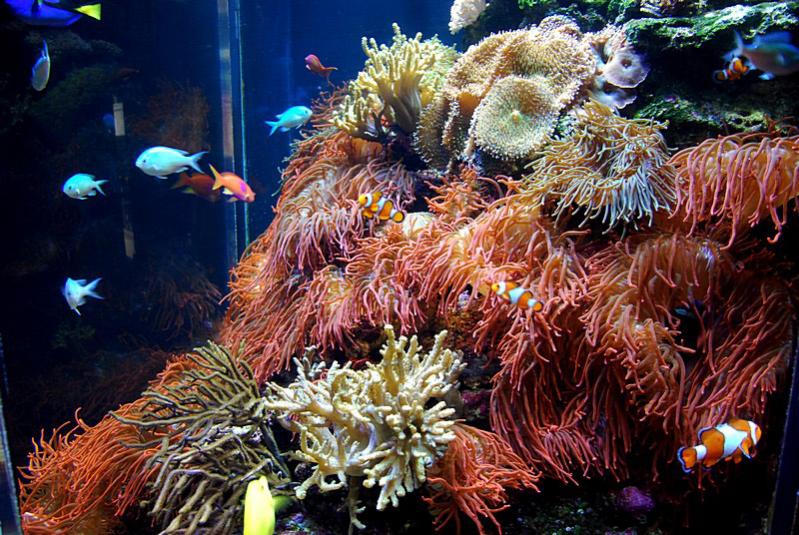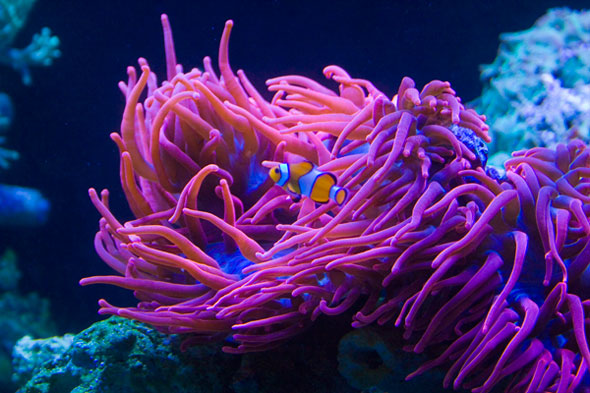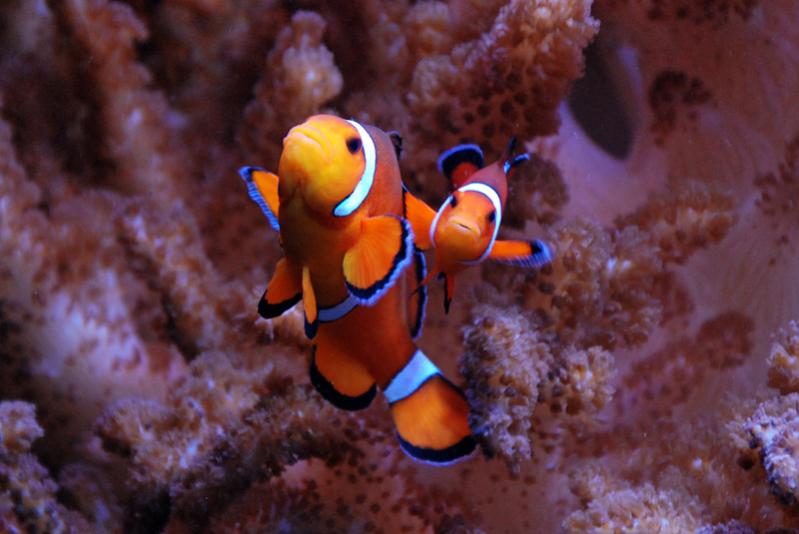With the release of Finding Nemo 3D this week, we wanted to help movie-goers who are interested in keeping their own saltwater reef aquarium.
Nemo and Marlin: Clownfish
Nemo is the main character of the film and Marlin is his over protective father. Both Nemo and Marlin are clownfish which are also called Anemonefish due to their symbiotic relationship with these invertebrates. There are many species of clownfish found in the tropical reef waters of the Pacific and Indian Oceans as well as the Red Sea. Finding Nemo takes place on The Great Barrier Reef off the east coast of Australia. Given the location of the movie combined with their appearance Nemo and Marlin are likely Amphiprion percula otherwise known as "Percula Clownfish" or "True Percs". Amphiron ocellaris is an almost indistiguishable species of clownfish often sold as "False Percs".
Clownfish are the most common fish in saltwater aquariums. They are fairly hardy and adapt well to captivity. Unlike the movie which depicts Nemo being collected from the ocean, most clownfish available for purchase have been captive bred which means that wild populations are not being harmed by the aquarium trade. Captive bred fish are also better suited for aquariums because they are already acclimated to captivity which ensures a higher chance of thriving and less chance of diseases that are prevalent with wild clownfish.
In the wild, Percula and Occerlais clownfish are believed to live approximatley 6-10 years. The ocean is a fish eat fish world and in an environment with no predators and a deligent aquarist, clownfish have been known to live more than 20 years. Percula and Occelaris clownfish are reported to grow to 4.3-inches long...although most captive clownfish grow to approximately 3.5-inches.
It is unlikely you will find a clownfish with a small fin like Nemo's. However, clownfish breeders have selectively bred fish for coloration and patterns. These designer clownfish are sold under names like Picasso clownfish, Snowflake Clownfish, Black Ice Clownfish, Phantom Clownfish, and Platinum Clownfish...which is all white!
Clownfish form a symbiotic (hosting) relationship with anemones. Watching a clownfish interact with their host anemone is fun and is always a hit when you show guests your aquarium. However, clownfish do not require an anemone to thrive in a reef aquarium environment. In fact, Clownfish will often host in non-anemone corals. Nearly any coral can be used as a host for clownfish. This is good because anemones can get big and eat other fish ...making a surrogate host preferred by many reefkeepers.
Consider a Pair!
You may want to consider a pair of clownfish. While they will live alone in an aquarium, clownfish do well in pairs. If you get two young clownfish, they will automatically form a pair. When clownfish are born they are sexless! When they are adults, the largest and the most dominant fish will become a female and the second most dominant fish will become a male.
You should plan to have only one pair of clownfish in your aquarium because they will fight with each other in an confined environment.
Clownfish will readily breed in captivity. While rearing the young requires a lot of dedication and setup, it is one of the easier reef aquarium fish to breed.
Tank Requirements
The "inches per gallon" rules that often are applied in the aquarium industry are poor indicators of tank size. Rather than looking at size, a better method is to look at the requirements of the animals you want to keep. Clownfish do not require as much swimming area as many other reef fish as they tend to stay in a small area (usually around their anemone).
The minimum size for a Percula or Occelaris clownfish is a 12-gallon aquarium. However, a 29-gallon aquarium is more ideally suited especially if you want a pair of clownfish. If you plan to have other fish, you should select the size of your aquarium considering their requirements as well. The aquarium should be outfitted with a tight fitting lid or mesh top to prevent jumping.
Clownfish are territorial and can become aggressive if other fish are in their space. It is best if you have an idea of which fish you would like to keep, to add them in the order of least to most aggressive. There is no guarantee that the fish will get along, but adding them this way will give them a better chance of co-existing.
Selecting & Acclimating Your Clownfish
You should not introduce livestock to your tank until the tank is done cycling. Cycling is the process of bacteria becoming established so that ammonia waste (aka, fish poop) can be treated.
When selecting your clownfish, they should be brightly colored and actively swimming. Check them to be sure they do not have white spots or other diseases. Their eyes should be clear with no haze. Their nose should have a gentle angle and not be too blunt (a common issue with poorly bred/raised fish). Have the store feed the fish you are considering to be sure it is eating prior to purchase.
To reduce your clownfish's stress level during the ride home, ask the store to put the bag into a paper bag ...the darkness will help your clownfish relax. Prior to adding your new clownfish to the tank, you should acclimate it slowly to the new water. To acclimate your clownfish, place the fish into a clean large container (free of chemicals...buckets are ideal) and "drip acclimate" your new clownfish (most local fish stores should carry drip lines so you may want to purchase one with your clownfish). For most fish, drip acclimation can be performed in 20-30 minutes. The water volume in the bucket is normally trippled from the original water in the bag during this procedure. A drip line should have an adjustment valve so that you can start slow and gradually increase the drip rate. The goal of acclimation is to slowly match the tank temperature and pH. Use a net to remove your clownfish from the bucket and place it into your tank. Do not pour the bucket containing fish store water into your tank. This water often contains copper and other disease treatments that will be harmful if you want to keep corals or other inverts.
It is common for clownfish to go into hiding for a couple days after being first introduced into a new tank. A tank that doesn't have any other fish in it, tends to cause clownfish to remain hidden longer. Just give it time to get familiar with its new home...remember in the ocean its a fish eat fish world and this natural instinct is the difference between life and death on the real reef.
Once your new clownfish is swimming around, you should feed it. Clownfish should be fed quality marine fish pellets or fresh/frozen foods such as mysis shrimp, pieces of squid, prawns and mussels. They should be fed daily. It is best to feed small amounts more frequently. Be careful to only feed as much as the fish eat since overfeeding will pollute their water.
As always feel free to ask any questions you may have here on CaptiveReefs.com. We are happy to help you be a successful reefkeeper and gain more enjoyment out of your aquarium.
Special thanks to the members who's photos we used in this article, in order of appearance: @BeakerBob , @jimsflies , @luisgo , @ReefTech , @luisgo , @BeakerBob
[Timezone Detection]
Create Account - Join in Seconds!
-
09-12-2012, 10:16 PM #1
 Finding Nemo: A quick guide to keeping Clownfish
Finding Nemo: A quick guide to keeping Clownfish
Last edited by jimsflies; 11-05-2012 at 12:49 PM.
 BeakerBob liked this post
BeakerBob liked this post
-
09-13-2012, 07:53 AM #2

Great article Jim!
BeakerBob - Past MMMC Club President, current Board Member
-
09-13-2012, 10:13 AM #3

Thanks Bob. Hopefully, it helps some folks get into this great hobby on the right foot.
-
09-22-2012, 08:43 AM #4

oops wrong thread, lol.
good read though.
Similar Topics
-
Cool Win tix to see Finding Nemo 3D!
By jimsflies in forum CR ContestsReplies: 14Last Post: 09-22-2012, 08:44 AM







 Reply With Quote
Reply With Quote


